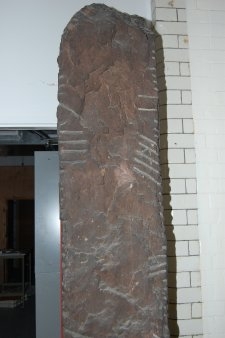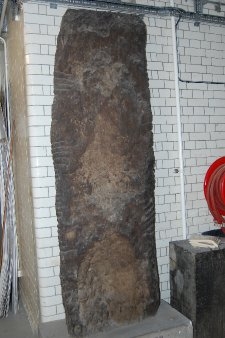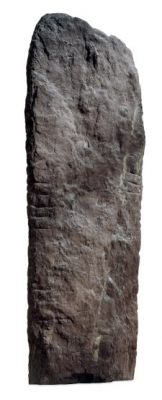To search the RPR site click here
Lane Fox and Ogam Stones
See here for a full list of all the objects known to have been donated to the British Museum by Pitt-Rivers 1866-1900.
The first contact that we definitely know about between Pitt-Rivers (or as he was then, Lane Fox) and the British Museum occurred in 1866 when he was thirty-nine. It was Pitt-Rivers’ decision to donate three sandstone standing stones known to him as ‘ogham (or ogam) stones’ from Ireland [1866,0511.1-3], one of which is on public display in the Great Court of the Museum to this day [1866,0511.3] These are definitely not the first objects that Pitt-Rivers collected, nor those that he first donated to an institution but they were found very early on in his collecting history. [1] Chapman indicates that Franks ‘helped to engineer the reception of Fox’s Ogham stones’. [1981: 142; he gives the date as 1865 [sic] though he references the ‘British Museum Book of Presents 1866-68 f. 94. Donated 10 May 1866’]
These objects were acquired by Pitt-Rivers when he was serving as Assistant Quartermaster General with the British Army in Cork. The stones are from Roovesmore Rath in County Cork and date from the fifth to the seventh century AD. [2] The stones are all inscribed with Celtic writing, the one on display saying ‘[Stone] of Vedac, [son] of Tob of the Sogain’. [3] These stones are large, ranging from 191 cms [.3] to 225 cms [.1 and .2] Pitt-Rivers had investigated this site in 1865
On 9 April 1866 Pitt-Rivers read his first learned society paper to the Archaeological Institute in London about his exploration of Roovesmore, the paper was published the following year. [4] [Chapman, 1981: 248; Twohig, 1987: 43] The rath, as he explained, was ‘half way between Cork and Macroom, and to the south of the river Lee’. [1867: 123] In this paper he explained that during his examination of the rath he had discovered several stones with ogham inscriptions which were hard to decipher given their position in the roof of crypt. He had decided because of the condition of the lintel and his belief that the roof might collapse, that in ‘this circumstance, coupled with the impossibility of reading the oghams as they were then placed, seemed to make it desirable in the interests of archaeology, that the stones should be removed before they were lost in the impending ruin of the building’. [1867: 125] He reports that the owner was glad to help him in this destruction of the site as he had ‘long desired to remove the rath as an impediment to his farm’. [1867: 125]
The task of removing these stones was no easy matter, as Pitt-Rivers estimated that the ‘largest one of them weighing about a ton and a half’. [1867: 125] However he succeeded eventually and as he recounts, ‘conveyed [them] to Cork, and ultimately to London, where they have been deposited in the British Museum. He was most fortunate that the Cork Steam Company who apparently saw them as ‘monuments of general interest’, ‘very liberally offered to take them to London free of cost’. [1867: 125-6; Chapman, 1991:142]
It is clear from Pitt-Rivers’ account that he thought the stones had originally been standing stones, ‘serving to mark a grave, a boundary, or to commemorate some remarkable event’ but that at some later date they had ‘been employed by the builders of the crypt as a handy material for their purpose, and inserted in the roof of the chamber’. [1867: 125]
From Pitt-Rivers’ account to the Archaeological Institute it is not clear why he decided to give these artefacts to the British Museum but one motive must surely have been size: such large pieces of stone would prove problematic to store for any collector, however wealthy. Another may have been his desire to publicise his first real excursion into the world of archaeology. The British Museum was (and remains) probably the pre-eminent museum in the British Isles and it is still esteemed an honour for it to accept a gift from any donor. It was during his service in Ireland between August 1862 and 1866 that he first got involved directly in archaeological exploration. As Twohig makes clear by this date Pitt-Rivers had obviously informed himself of the latest archaeological developments and acquired several artefacts:
'At the meeting [of the Cuverian Society in Cork in 1864] [Pitt-Rivers] displayed various artefacts, animal bone and samples of breccia excavated by Lartet and Christy at Les Eyzies in southern France. These were presented to the Royal Cork Institution. [6] ... Pitt-Rivers also showed flints from St. Acheul and from Reigate and others from Northern Ireland and from North America ... He showed himself well acquainted with current research, and much influenced by the work of Sir Charles Lyell, Lubbock and Boucher de Perthes.’ [1987: 40]
As well as being a member of the Royal Cork Institution, in June 1864 he was elected as a Fellow of the Society of Antiquaries, one of his proposers being Henry Christy from whom he obtained several objects, listed above.
He may also have been spurred on in this donation by his awareness that there were similar objects in the Henry Christy collection which had been very recently bequeathed to the British Museum. [1867: 131] It is clear from the second half of Pitt-Rivers 1867 paper that he had done substantial research into similar markings on a variety of other objects from around the world including a ‘Esquimaux’ [Inuit] tool held by the British Museum. [1867: 132] He had also done a substantial amount of reading about such inscriptions, citing several naval authorities for information about ‘Esquimaux writing’, for example. It is also clear that he had done substantial fieldwork, or archaeological survey work, describing the position of many raths he had explored in Ireland, although he is unlikely to have managed to visit all of the 10,000 raths he had calculated to exist from examining the ‘Ordnance Map’, at that time a much more complete record of ancient monuments in Ireland than the Ordinance Survey for England.
The comparison of living cultures such as the Inuit of North America and ancient groups like the Celts was of course standard practice at the time. Pitt-Rivers believed that anthropological evidence could be used to illuminate the past, particularly those aspects of its material culture that had been lost. Franks was the Keeper who would become responsible for the Pitt-Rivers ogham stones from Roovesmore. He described them in his summary of acquisitions in 1866 as those ‘remarkable monuments of palaeographic art’. [Franks, 1867: 440]
These were not the only ogham items that Pitt-Rivers owned, there were three others in the founding collection that are now held in Oxford [1884.98.4-6] These pieces of stone (much smaller than those given to the British Museum at between 292 mm and 758 mm) were all obtained from John Windele in 1864. Their more portable size may explain why Pitt-Rivers retained them in his first collection rather than disposing of them shortly after he acquired them, as he had the stones at the British Museum. They were found near the church of ‘St Olans’ [sic] Knockrour near Aghabulloque in County Cork. In a document held in the PRM manuscript collections signed by Pitt-Rivers it transpires that in June 1868 he sent the inscriptions to Richard Brash of Cork to translate. Brash was able to provide new information on the stone 1884.98.5 including identifying the finder, a John Coakley, the tenant of the lands in 1851, and a previous owner, Mr Cross Fitzgibbon.
The museum also holds an artefact which may show the way that Pitt-Rivers used objects in museum display; a rectangular block of wood with notches on two sides. Attached to one end of the block is a chain for suspension. Written on end of the block is "OGAM ALPHABET". By each notch or set of notches a letter has been written in ink. From the end with the chain the letters are as follows: B L F S N H D T C Q M G NG E[?] R A O U E I. [1998.12.1] this was found in the Museum in Oxford on 9 February 1998 and its early history is unknown.
AP May 2013
Notes
[1] The first object he is known to have donated to an institution was a model of a bridge at Alcantara, which he gave to the United Service Institute before March 1850 [Dan Hicks, pers. comm.] Most of his early donations were to this institution, and related to his work in the Army.
[2] The Oxford English Dictionary defines a rath as ‘Chiefly in Ireland: an enclosure of roughly circular form made with a strong earthen wall, and originally serving as a fort and place of residence; an earthen ring fort.’ "rath, n.1". OED Online. March 2013. Oxford University Press. 24 April 2013
[3] This information is taken from the entry for this object in the British Museum database accessed on 24 April 2013.
[4] See further read for details of this publication.
Further Reading
Chapman, William Ryan. 1981. ‘Ethnology in the Museum: A.H.L.F. Pitt Rivers (1827–1900) and the Institutional Foundations of British Anthropology’, University of Oxford: D.Phil. thesis.
Chapman, W.R. 1991. 'Like a Game of Dominoes: Augustus Pitt Rivers and the Typological Museum Idea’, in S. Pearce [ed.] Museum Economics and the Community vol. 2 New Research in Museum Studies London: Athlone.
Fox, A.H. Lane. 1867. 'Roovesmore Fort, and stones inscribed with oghams, in the parish of Aglish, County Cork’, Archaeological Journal, 24 (1867), pp. 123-139.
Franks, A.W. 1867. ‘Account of Additions made to the Collections of British Antiquities in the British Museum during the year 1866’, Proceedings of the Society of Antiquaries of London 3 pp. 435-445>
Twohig, Elizabeth. 1987. 'Pitt-Rivers in Munster, 1862-65/6', Journal of the Cork Historical and Archaeological Society 92 (251), 1987 pp. 34-46.






